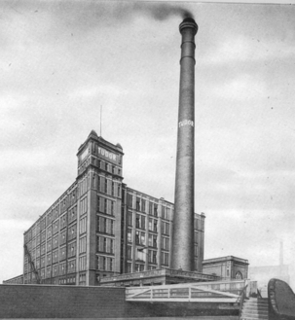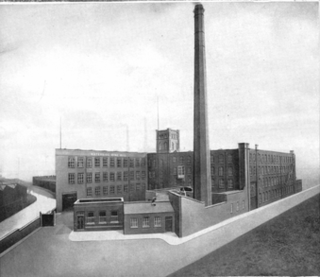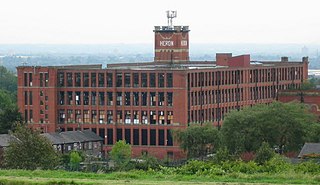
Bollington is a town and civil parish in Cheshire, England, to the east of Prestbury. In the Middle Ages, it was part of the Earl of Chester's manor of Macclesfield and the ancient parish of Prestbury. In 2011, it had a population of 8,310.

Quarry Bank Mill in Styal, Cheshire, England, is one of the best preserved textile factories of the Industrial Revolution. Built in 1784, the cotton mill is recorded in the National Heritage List for England as a designated Grade II* listed building. The National Trust, which runs the site as a museum, calls it "one of Britain's greatest industrial heritage sites, home to a complete industrial community". Quarry Bank Mill was established by Samuel Greg, and was notable for innovations both in machinery and also in its approach to labour relations, largely as a result of the work of Greg's wife, Hannah Lightbody. The relationship between owners and employees is explored in the 2013 television series The Mill.

A cotton mill is a building housing spinning or weaving machinery for the production of yarn or cloth from cotton, an important product during the Industrial Revolution in the development of the factory system.

Textile manufacture during the Industrial Revolution in Britain was centred in south Lancashire and the towns on both sides of the Pennines. In Germany it was concentrated in the Wupper Valley, Ruhr Region and Upper Silesia, in Spain it was concentrated in Catalonia while in the United States it was in New England. The main key drivers of the Industrial Revolution were textile manufacturing, iron founding, steam power, oil drilling, the discovery of electricity and its many industrial applications, the telegraph and many others. Railroads, steam boats, the telegraph and other innovations massively increased worker productivity and raised standards of living by greatly reducing time spent during travel, transportation and communications.

Regent Mill, Failsworth is a Grade II listed former cotton spinning mill in Failsworth, Oldham, Greater Manchester. It was built by the Regent Mill Co Ltd. in 1905, and purchased by the Lancashire Cotton Corporation in 1930. It was taken over by the Courtaulds Group in 1964. On ceasing textile production it was occupied by Pifco Ltd, and then by Salton Europe Ltd who now occupy this site. It was driven by an 1800 hp twin tandem compound engine by Buckley & Taylor. It became a ring mill with 60,000 spindles in 1915, all provided by Platt Brothers.

Tudor Mill was cotton spinning mill in Ashton-under-Lyne, in the historic county of Lancashire, England. It was built between 1901 and 1903 for the Ashton Syndicate by Sydney Stott of Oldham. Tudor Mill was next to the Ashton Canal Warehouse at Portland Basin. It ceased spinning cotton in the 1960s and was used as a warehouse until it was destroyed by fire in 1970

Rock Mill was cotton spinning mill in the Waterloo district of Ashton-under-Lyne, Greater Manchester, in England. It was built between 1891 and 1893 for the Ashton Syndicate by Sydney Stott of Oldham. Rock Mill was built on the site of Wilshaw Mill retaining and using the octagonal chimney. It ceased spinning cotton in the 1960s and was demolished in 1971; the site became the location for the town's first Asda supermarket, which opened in 1972, until Asda relocated to a much larger new store site in Cavendish Street in 1989.

Texas Mill was a cotton spinning mill in the Whitelands district of Ashton-under-Lyne, Greater Manchester, in England. It was built between 1905 and 1907 for the Ashton Syndicate by Sydney Stott of Oldham. It was destroyed in a massive fire on 22–23 October 1971. It had been re-equipped as a ring mill for spinning artificial fibres when it was destroyed.

Broadstone Mill was a double cotton spinning mill on the eastern bank of the Stockport Branch Canal in Reddish, Stockport, Greater Manchester, in England. Construction of the twin mills commenced in 1903 and was completed in 1907. They closed in 1957, and the southern mill and engine houses were demolished in 1965. The northern block went into multiple usage. It is now part of the Houldsworth Village development. It is used as a centre for small businesses, and a shopping outlet.

Waterside Mill, Ashton-under-Lyne was a combined cotton spinning weaving mill in Whitelands, Ashton-under-Lyne, Greater Manchester, United Kingdom. It was built as two independent factories. The weaving sheds date from 1857; the four-storey spinning mill dates from 1863. The spinning was taken over by the Lancashire Cotton Corporation in the 1930s. Production finished in 1959. Waterside Mill was converted to electricity around 1911.

Heron Mill is a cotton spinning mill in Hollinwood, Oldham, Greater Manchester. It was designed by architect P. S. Stott and was constructed in 1905 by the Heron Mill Company Ltd next to Durban Mill. It was taken over by the Lancashire Cotton Corporation in the 1930s and passed to Courtaulds in 1964. Production ended in 1960, and it was used by Courtaulds for offices, warehousing, and some experimental fabric manufacture. Courtaulds occupation ended in 1994.

Elm Mill, is a four-storey cotton spinning mill in Shaw and Crompton, Greater Manchester, England. It was built in 1890 for the Elm Spinning Company Ltd., and was called Elm Mill until it closed in 1928. It was revived by the Lancashire Cotton Corporation in 1929 and called Newby Mill. LCC and all their assets passed to Courtaulds in 1964. Production at Newby finished in 1970, and it was used for warehousing. Subsequently, now named Shaw No 3 Mill, it became part of Littlewood's Shaw National Distribution Centre.

Silk throwing is the industrial process wherein silk that has been reeled into skeins, is cleaned, receives a twist and is wound onto bobbins. The yarn is now twisted together with threads, in a process known as doubling. Colloquially silk throwing can be used to refer to the whole process: reeling, throwing and doubling. Silk had to be thrown to make it strong enough to be used as organizine for the warp in a loom, or tram for weft.

Ellenroad Mill was a cotton spinning mill in Newhey, Milnrow, Rochdale, Greater Manchester, England. It was built as a mule spinning mill in 1890 by Stott and Sons and extended in 1899. It was destroyed by fire on 19 January 1916. When it was rebuilt, it was designed and equipped as a ring spinning mill.

Pear New Mill is a former Edwardian cotton spinning mill on the northern bank of the River Goyt in Bredbury, Stockport, Greater Manchester, England. It is a Grade II* listed building.

Congleton, Macclesfield, Bollington and Stockport were traditionally silk-weaving towns. Silk was woven in Cheshire from the late 1600s. The handloom weavers worked in the attic workshops in their own homes. Macclesfield was famous for silk buttons manufacture. The supply of silk from Italy was precarious and some hand throwing was done, giving way after 1732 to water-driven mills, which were established in Stockport and Macclesfield.

Bollington is a civil parish in Cheshire East, England. It contains 66 listed buildings that are recorded in the National Heritage List for England, all of which are at Grade II. This grade is the lowest of the three gradings given to listed buildings and is applied to "buildings of national importance and special interest". In the parish is the town of Bollington, which is surrounded by countryside leading up to the foothills of the Pennines on the east. To the south of the town is the long Kerridge Hill, which has been a source of industry, with coal mining on its east side and quarrying on the west side. These quarries are the source of Kerridge stone-slate, which is used to roof many of the houses in the locality.

Swan Lane Mills is a former cotton mill complex in Bolton, Greater Manchester. All three mills are Grade II* listed buildings. The mills were designed by Stott and Sons of Oldham. When completed, the double mill was the largest spinning mill in the world. It was granted Grade II* listed status on 26 April 1974. Number 3 Mill was separately listed as Grade II* on the same day.

De Museumfabriek is a museum in Enschede, Twente, in the Netherlands. The new museum is located partly in a renovated Jannink textile factory, in reference to Enschede's textile history, and partly in an adjourning new building designed by the Amsterdam-based firm SeARCH. The project architect was Bjarne Mastenbroek. It is an Anchor point on the European Route of Industrial Heritage.





















